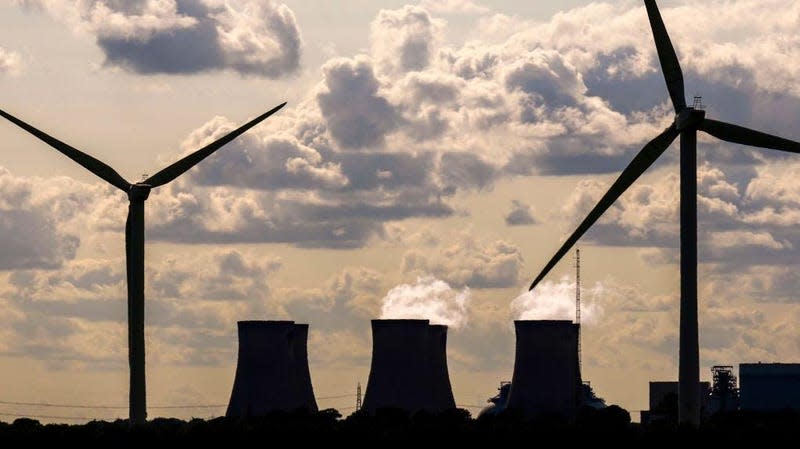Sébastien Roblin
Tue, September 26, 2023

Royal Navy Nuclear Sub Completes 6 Month PatrolRoyal Navy - Wikimedia Commons
On September 11, a Vanguard-class ballistic missile submarine glided back to its port of Clyde Naval Base in a zombie-like state—the sound-dampening anechoic tiles on its hull bleached pale white by barnacles where they weren’t stained sickly green with algae. It was the very image of tired.
That haggard sentiment was likely shared by the sub’s roughly 130-person crew, and for good reason. The craft and its crew are believed to have spent 195 days on patrol, the vast majority of it submerged. Many allege that this sets a record for the longest known patrol by a Royal Navy submarine.
According to website Navy Lookout, however, its sister ship Victorious may have endured a couple weeks longer, completing a 207-day patrol in 2021. The website claims that Vanguard-class patrols are averaging 163 days (5.5 months), up from the previous 3 months average.
The Royal Navy refuses to confirm deployment lengths, per official policy. While the returning sub’s identity is unstated in reports, reportedly, only the Vigilant and Vanguard are operationally available in 2023.
While the sub’s crew can justly take pride in completing this stupendously long mission, that it was deemed necessary is not a good thing. Regular nuclear deterrence patrol by the U.S. Navy’s Ohio-class SSBNs last two or three months, while their record for longest ever SSBN patrol—set by the Gold crew of USS Pennsylvania in 2014—was just over 4 and a half months.

HMS Vengeance enroute to Devonport for a refit in February 2012.Handout - Getty Images
The Royal Navy’s four Vanguard-class subs are nuclear-powered ballistic missile submarines (or SSBN)—often referred to as ‘boomers’ or ‘bombers’ in U.S. and Royal Navy parlance. While attack submarines prowl across the ocean looking for trouble, a boomer just wants to quietly creep around and be left alone—waiting just in case the call ever comes to end the world as we know it by launching a strategic nuclear missile attack. Hopefully, it never does.
London no longer bothers with land- or air-based nuclear weapons, such as its long retired ‘V-bombers.’ Sea-based nukes are expensive, but hard to preemptively attack—when submerged, they effectively guarantee apocalyptic retribution, even if an adversary executes a successful first strike. For over a half century, the Royal Navy has always had at least one SSBN on patrol at sea, armed with nuclear missiles 365 days a year. The mission is known as Continuous At-Sea Deterrence (CASD).
The prime culprit for the extra-long patrols is the class’s lead ship HMS Vanguard. In 2012, the Royal Navy discovered that the Vanguard’s reactor was leaking radiation into coolant water. This development was revealed to the public in 2014.
Vanguard thus spent seven years being refueled and overhauled to the tune of £500 million. These refurbishments included repairs related to its hair-raising collision with French SSBN Le Triomphant in February of 2009, and replacement of much of the tail section and hydroplane bearings. Vanguard finally departed the shipyard at Devonport in May of 2023.

HMS Vanguard arriving at Naval Base Clyde at Faslane in November 2010.CPOA(Phot) Tam McDonald - Wikimedia Commons
During those years three subs were forced to shoulder the continuous patrols—even though they too inevitably required time for maintenance and repairs. Indeed, the same month that Vanguard took back to the sea, Victorious arrived in Devonport to begin a major refit, following an onboard fire in September of 2022.
These problems stem from the risks of operating such a small SSBN force with little redundancy. Sustaining continuous deployment of SSBNs, with their nuclear reactors and missiles, is so expensive that only four other countries currently do it: France, Russia, the U.S. and now China. And though China has 20 times the UK’s population, it has only six Type 094 Jin-class SSBNs.
The psychic toll of underwater boredom
The Royal Navy insists that it has compensated the crew with “extra payment after an extended period at sea.” But many veteran submariners agree that six months underwater is longer than humans should spend in an isolated and confined environment—especially with virtually no communication with the outside world.
Commenting in 2022, on two Vanguards that performed 157-day-long patrols—former Royal Navy SSBN commander Rob Forsyth—noted in a blog post that the “great danger is that this unchanging routine, week after week, leads to boredom, complacency and an inevitable drop-off in standards […] personal relationships are tested to the limit.”
For comparison, Forsyth states that his Cold War-era patrols lasted only 50-75 days (averaging two months), and were carried out in allegedly less cramped conditions than the Vanguard’s. Even then, he wrote that “major effort was still needed to keep crews stimulated and alert and not allow them to withdraw into themselves […].” Forsyth noted that he himself adopted quirky habits, like tying his scrub brush to a leash and taking it for a walk once a week.
Regarding a 111-day patrol by the Warspite from 1982 to 1983, he wrote that he was “told that operating errors, flare ups between crew members and disciplinary problems started to be a problem after the half-way mark, around 50 days in.” He adds that long patrols led to loss of sight, weight, general fitness and spatial awareness, and that the lack of sunlight lead to Vitamin D deficiencies.

Biscuits and tea for Prime Minister Cameron and crew of Vanguard-class submarine HMS Victorious while at sea off the coast of Scotland on April 4, 2013.AFP - Getty Images
The Telegraph interviewed a former attack submarine commander, Ryan Ramsey, who said that he would “be surprised if there aren’t mental health challenges after this because it’s extreme. The reality is they shouldn’t have to do that. Those boats were designed to go on three-month patrols.”
Breakdowns in discipline in Royal Navy submarines have received periodic media attention in recent years, whether related to harassment and forbidden sexual relationships, the abuse of hard drugs and alcohol, or raucous partying. At one point, in 2017, such scandals culminated in 10% of the Vigiliant’s crew being discharged, investigated, or compelled to resign—including the captain and first officer.
The Ministry of Defence’s unwillingness to discuss the length of nuclear patrols on the basis of operational security has earned the ire of critics who argue that the strain on the crew from lengthy patrols increases the risk of a mishap involving the UK’s nuclear delivery systems.
London's Nuclear Vanguards

A Vanguard-class submarine departs Faslane on September 2009.
The Royal Navy’s four Vanguard-class submarines—Vanguard, Victorious, Vigilant, and Vengeance—were commissioned between 1993 and 1999 at a cost of £3.75 billion per hull. Each measures 150 meters long (one and a half football fields) and displaces 17,500 tons while submerged. Originally built for 25-year service lives, they’ve received life extensions to operate 35-40 instead. Their Rolls-Royce PWR2 pressurized water reactors generate air and sustain propulsion such that the submarine can remain submerged nigh indefinitely—at least as long as there’s food for the crew.
Though Vanguards have four torpedo tubes for self-defense, their primary weapons are stored in their sixteen missile tubes. These Trident II D5 ballistic missiles—the same type used by U.S. Navy boomers—are each capable of releasing multiple independent nuclear warheads. In practice, since 2010, the subs have gone to sea loaded with only 8 missiles stuffed with no more than 40 warheads between them. London’s total stockpile is in flux, however. During the 2010s, it was reduced to roughly 160 warheads, with no more than 120 operationally available. In 2021, the government announced plans to regrow the stockpile to 260 nukes.
The cost and purpose of the UK’s nuclear deterrence force is criticized in left-leaning quarters of British politics. One complication is that all Royal Navy submarines are based at Faslane, Scotland. Should Scotland vote for independence in a referendum, use of Faslane by SSBNs could be denied, as Scottish independence parties oppose the base’s use for nuclear deterrence.

Nicola Sturgeon, former leader of Scottish National Party and First Minister of Scotland attends anti-nuclear arms protest in London (Trident being the name of the missile on Vanguard-class submarine) on February 27, 2016.
Political risks aside, the Vanguards should (in theory) be replaced by a succeeding generation of Dreadnaught SSBNs—with planned services lives of fifty years—by the 2030s. The initial phases of construction for the first three Dreadnaughts began in 2016 at BAE Systems’ Barrows-in-Furness shipyard. The Dreadnaughts will be slightly longer than the Vanguards and significantly larger, at 153.6 meters and nearly 19,000 tons displacement submerged.
Many of the Dreadnaught’s reported innovations appear to center on improving quality of life for the crew. That includes separate quarters and bathrooms for male and female crew, new dedicated gym facilities and sick bay, and a lighting system designed to simulate an artificial day/night cycle. That could make a six month patrol more tolerable—even if still not recommended.

Infographic on characteristics of the successor SSBNs posted by Royal Navy in 2016, the year the first steel for lead ship HMS Dreadnaught was cut.






















